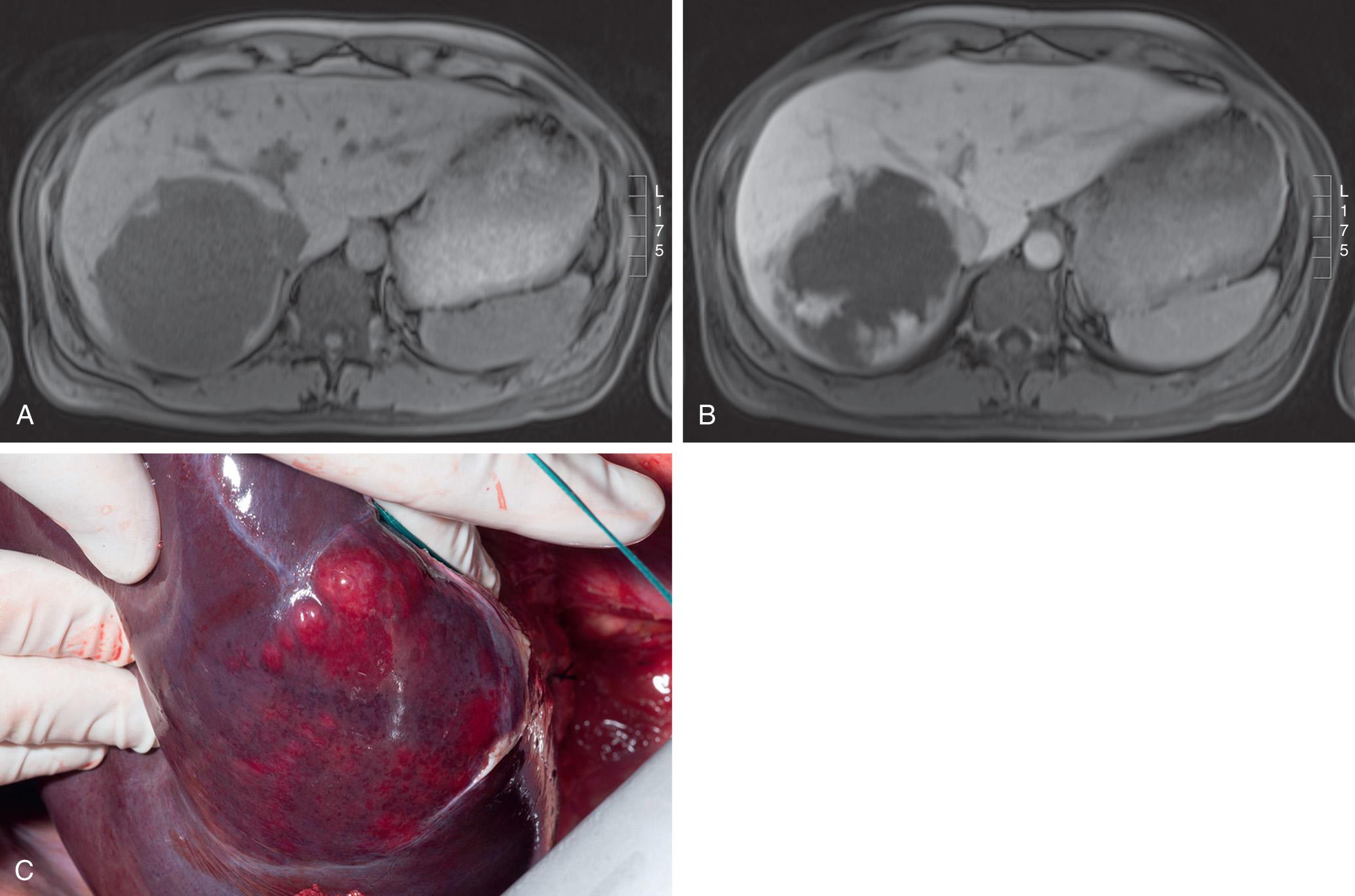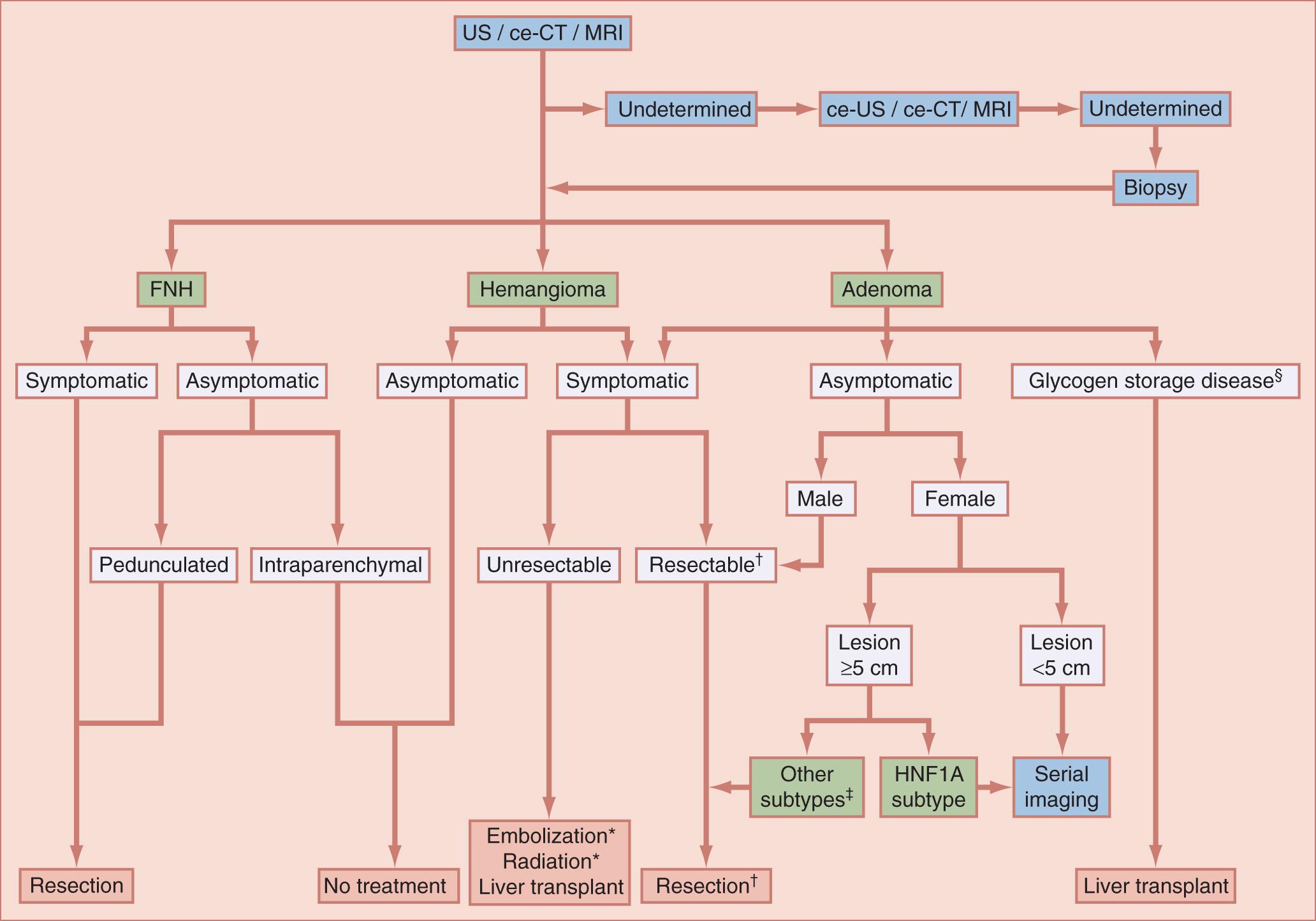Physical Address
304 North Cardinal St.
Dorchester Center, MA 02124
The widespread use and progress in modern imaging modalities have led to an increase in the incidental finding of asymptomatic benign hepatic lesions, including cystic and solid tumors. In contrast to most cystic lesions, the latter group is composed of tumors that often harbor true neoplastic characteristics. The most frequent benign solid lesions are hemangioma and focal nodular hyperplasia (FNH), which only rarely require treatment or long-term follow-up. Less frequent lesions include hepatocellular adenoma and angiomyolipoma, which carry a higher risk for complications, such as bleeding or malignant transformation, and therefore are more likely to necessitate surgical intervention. To account for these marked differences in biology and clinical characteristics between the different tumor types and ensure an accurate diagnosis, as well as an appropriate management of the patients, it is crucial to have a thorough understanding of clinical, biologic, radiologic, and pathologic characteristics of each liver lesion. Indeed, refinements in magnetic resonance imaging (MRI) and contrast-enhanced ultrasonography (ce-US) and computed tomography (ce-CT) allow an accurate diagnosis based only on imaging in a majority of cases and have thus reduced the need for percutaneous biopsy or surgical resection for definitive diagnosis. After the diagnosis has been established, the vast majority of benign hepatic neoplasms do not require surgical resection. However, indications for surgery include diagnostic uncertainty after an extensive diagnostic work-up, symptomatic patients, lesions with a mass effect on gastrointestinal (GI) organs or the biliary tree and tumors that have a potential for complications, as well as malignant transformation. In this chapter, we will cover solid benign hepatic lesions in adults and describe the etiology, clinical presentation, diagnostic work-up, and treatment strategy for each tumor type.
Hepatic hemangiomas are also termed cavernous hemangiomas and account for approximately 70% off all solid benign liver tumors. The prevalence of this most common type of benign neoplasms of the liver is estimated to be in the range from 3% to 20% of the population ( Table 131.1 ). Cavernous hemangiomas have a female predilection, with a female-to-male ratio of 5 : 1, and are most frequently detected in middle-aged women. They are usually small (<5 cm). Lesions that are larger than 10 cm have been arbitrarily termed giant hemangiomas. Hemangiomas are often solitary, even though multiple lesions may be present in up to 40% of patients. If more than one lesion is present, these are usually located in the same hepatic lobe.
| Cavernous Hemangioma | Focal Nodular Hyperplasia | Hepatocellular Adenoma | |
|---|---|---|---|
| Prevalence | 3%–20% | 1% | <0.05% |
| Pathogenesis | Vascular malformation, congenital | Hyperplastic response to vascular malformation, hereditary | Steroid hormones (estrogen, progesterone, androgen), NASH, type I and III glycogen storage disease |
| Imaging | ce-US, ce-CT, MRI | ce-US, ce-CT, MRI | US, ce-CT, MRI |
| α-Fetoprotein | Normal | Normal | Normal |
| Macroscopic features | Dark purple, soft, compressible lesions that are well demarcated and frequently surrounded by a thin capsule (blood-filled “cyst”) | Light brown, well-circumscribed lobulated tumor without capsule and a central scar | Well-circumscribed masses with a pseudocapsule of compressed hepatic parenchyma. Areas of inhomogeneous, yellow-brown lipid-rich tissue, as well as hemorrhage, necrosis, and calcifications |
| Microscopic features | Cavernous vascular spaces lined by endothelium and separated by connective tissue; no biliary or portal structures | Normal hepatocytes arranged in thickened plates, containing Kupffer cells and hepatocyte-derived biliary ductules at the interface between fibrous bands and nodules, no bile ducts | Composed of large lipid and glycogen-containing hepatocytes arranged in plates, separated by dilated sinusoids that are fed by arterial perfusion |
| Complications | Mass effect, inflammatory reaction, Kasabach-Merritt syndrome | Mass effect, torsion of pedunculated FNH | Mass effect, inflammatory reaction, bleeding, hemorrhagic shock |
| Malignant transformation | No | No | Yes. Risk factors for malignant transformation include male gender, androgen use, b-HCA subtype and tumor diameter >5 cm |
| Treatment | Surgical enucleation or resection only if symptomatic; Liver transplantation, embolization and radiation if unresectable |
Surgical resection if symptomatic or pedunculated; cessation of hormonal therapy not recommended | Indication for surgical resection depends on size, gender, adenoma subtype Liver transplantation in exceptional circumstances; discontinue hormonal therapy |
Hemangiomas appear as dark purple, soft, and compressible lesions that are well demarcated and frequently surrounded by a thin capsule. They arise from endothelial cells that build multiple vascular channels, supported by fibrous septa, resulting in cavernous vascular spaces lined by endothelium and separated by connective tissue. They obtain their blood supply mainly from the hepatic artery and lack biliary or portal structures. By immunohistochemistry, the endothelium displays vascular as opposed to sinusoidal differentiation. Large tumors may have necrotic areas or dystrophic calcifications, and their lumens are often occluded by thrombi, which are caused by prothrombic conditions in these irregularly shaped vascular structures.
Hemangiomas are typically asymptomatic hepatic lesions that are incidentally discovered at laparotomy, autopsy, or during routine imaging studies for unrelated reasons. If symptoms are present, those are mostly observed in patients with giant hemangiomas and include abdominal pain and discomfort. Very large hemangiomas can cause mass effects due to their size, such as early satiety by gastric compression, biliary stasis, or vascular obstruction. Rupture is an extremely rare complication, even in very large hemangiomas or during pregnancy. Rarely, thrombosis of a part of the hemangioma can lead to an inflammatory reaction, which can result in abdominal pain accompanied by slight fever, loss of weight, anemia, thrombocytosis, and increased levels of fibrinogen. The adult Kasabach-Merritt syndrome constitutes a related but even less frequent complication, which mainly occurs in giant hepatic hemangioma but can also be observed in other vascular liver lesions. It is a local consumptive coagulopathy, which is caused by an intravascular coagulation, clotting, and fibrinolysis within the hemangioma. These effects can in turn lead to a secondary increase in systemic fibrinolysis and thrombocytopenia and result in a systemic disseminated intravascular coagulation, which is associated with a high mortality (30% to 40%) as a result of uncontrollable bleeding. This complication is reversible by surgical removal of the hemangioma.
Hepatic hemangioma is considered to be a vascular malformation or a hamartoma of congenital origin. Enlargement occurs by ectasia rather than hypertrophy or hyperplasia. The observation that hemangiomas have a clear female predilection, are mostly diagnosed in middle-aged women, and show an accelerated growth during puberty and pregnancy and with oral contraceptive use has led to the hypothesis that estrogen has a causative role for growth of hemangiomas. However, these associations have not been consistently found, and the expression of sex hormone receptors could not be clearly linked to hemangioma growth, and therefore the estrogen-driven theory has not been proven to date.
Hemangiomas can often be unequivocally identified by imaging studies because of their typical radiographic features. On ultrasonography, hemangiomas appear as a well-defined hyperechoic mass, with acoustic enhancement and sharp margins. However, larger lesions often have an atypical appearance because of calcifications or lumen occlusion by thrombi. In a fatty liver the lesion might actually appear hypoechoic compared with the surrounding parenchyma on ultrasound. When standard ultrasound does not provide an unequivocal diagnosis, contrast-enhanced examinations are necessary to differentiate the hemangioma from other lesions. Typical findings of such contrast-enhanced examinations, which include ce-US, ce-CT, and MRI, are rapid peripheral and nodular enhancement on arterial phases, followed by centripetal filling of the lesion ( Fig. 131.1 ). To date, MRI is considered to be the best imaging modality for the detection and characterization of hemangioma. Typical findings are hypointensity on T1-weighted sequences and strong hyperintensity on T2-weighted sequences. On diffusion-weighted MRI sequences, the signal of hemangioma weakens with increasing b-values, and consequently the apparent diffusion coefficient value is high. However, calcified, hyalinized, sclerotic, cystic, or pedunculated hemangiomas, as well as very slow filling lesions or hemangiomas with fluid-fluid level or capsular retraction can have an atypical MRI appearance and require the use of additional imaging modalities. Scintigraphy with technetium 99m pertechnetate–labeled erythrocytes documents gradual accumulation of red blood cells inside the hepatic lesion. Although the specificity is extremely high and can be further improved by using single-photon emission CT (SPECT), the technique is cumbersome and infrequently used. Hepatic angiography is also rarely used for diagnosis; yet it can be helpful in selected cases in which definitive diagnosis cannot be established by noninvasive imaging modalities. Classic angiographic features include the characteristic “cotton wool” appearance that circumscribes a large feeding vessel with displacement and diffuse pooling of intravenous contrast material. Percutaneous biopsy has a low diagnostic yield and carries the risk of severe bleeding complications. Therefore biopsies are limited to exceptional cases when diagnosis remains uncertain after the use of all available imaging modalities and techniques ( Fig. 131.2 ).


Most patients with hemangiomas do not have any symptoms or complications and therefore do not require any treatment. One series observed 97% of 249 patients with liver hemangioma for up to 14 years without adverse events or morphologic changes of the lesions. It has been concluded that asymptomatic patients with a firmly established diagnosis do not need to undergo serial imaging studies and a further follow-up is routinely not recommended. Women should neither discontinue oral contraception nor avoid pregnancy, and any specific advice regarding physical activities is also not justified.
Surgical intervention is necessary only in a small subset of patients. Indications for surgery include diagnostic uncertainty, severe symptoms, extrinsic compression of adjacent structures, inflammatory reaction, the Kasabach-Merritt syndrome, and the extremely rare spontaneous rupture. The most important surgical options include formal resection or enucleation using both open and laparoscopic techniques, following the same rules as for all other liver tumors. Enucleation is possible because of a pseudocapsule of compressed hepatic parenchyma between the hemangioma and the surrounding tissue. This technique offers the presumed advantage of maximal preservation of functional liver tissue and does not involve the transection of biliary structures. However, overall the advantages of enucleation are small, and we prefer standard liver resection for hemangioma. Occasionally, giant hemangiomas can be technically challenging to resect, and special surgical techniques, such as total vascular exclusion, must be used. In the extraordinary case of a technically unresectable, complicated giant hemangioma, liver transplantation can be considered as a feasible treatment option. In patients who do not qualify for surgical resection because of medical or technical reasons, arterial embolization or radiation therapy may be used as therapeutic alternatives. In the Kasabach-Merritt syndrome, the gold standard treatment is the removal of the underlying hemangioma, which will correct the consumptive coagulopathy. However, surgical resection of the hemangioma under these circumstances could be hazardous in the presence of uncontrolled coagulopathy secondary to disseminated intravascular coagulation (DIC). Therefore, perioperative administration of fresh-frozen plasma and platelet concentrates may reduce perioperative bleeding.
Become a Clinical Tree membership for Full access and enjoy Unlimited articles
If you are a member. Log in here